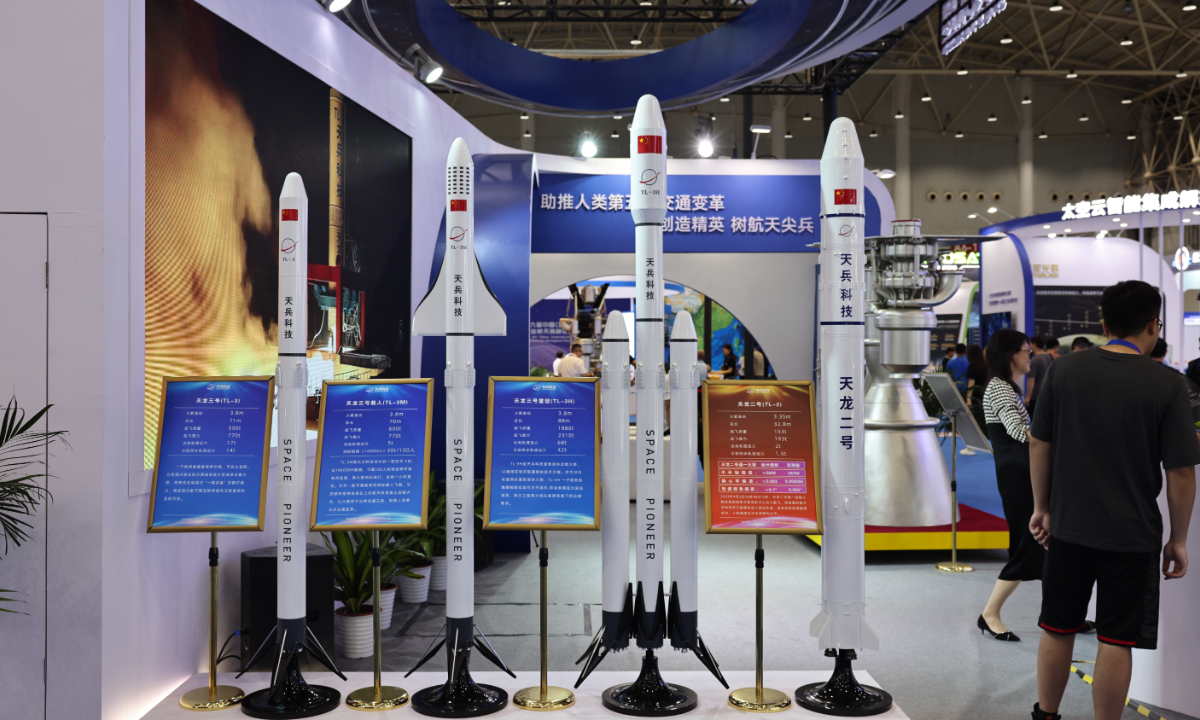Domestically made reusable rocket model fails maiden test flight, causing no casualties

Rockets and rocket engines on display in Wuhan on Wednesday. (Photo: Deng Xiaoci/GT)
A new domestically designed and manufactured large liquid-propellent reusable rocket model failed its maiden test flight and fell into the mountain area in Gongyi, Central China’s Henan Province, on Sunday, reportedly causing no casualties as of Sunday evening as nearby residents had been evacuated before the flight.
Videos posted online by local residents showed a rocket emitting black smoke before falling into the mountain and catching fire on Sunday afternoon.
According to media reports, the fallen rocket was related to the rocket test conducted by Space Pioneer, a Chinese private rocket company founded in 2019.
In March, the company revealed the maiden flight scheduled for its new large liquid-propellent reusable rocket model TL-3, also known as the Chinese “Falcon 9 equivalent” for its matching powerful design.
The videos uploaded online show that a cylindrical object on fire traced a parabola through the sky before crashing onto the ground, immediately followed by the sound of a huge explosion.
The city’s emergency management bureau said the explosion caused no casualties as of Sunday afternoon, according to Jimu News.
A local villager told Jimu News that the launch site was just 500 meters away from her home. Local authorities had evacuated all the nearby residents as of 10 am on Sunday morning and the residents had to wait for further notice about the time for their return.
Space Pioneer issued a statement on Sunday afternoon, explaining the condition of the test flight of its new large liquid-propellent reusable rocket model TL-3 carried out on Sunday afternoon, according to cls.cn.
During the test flight, a first-stage rocket ignited normally. However, due to structural failure at the connection point between the rocket body and the test stand, the rocket crashed in the deep mountains 1.5 kilometers southwest of the test pad, where the rocket body disintegrated upon impact.
Specially designed for China’s low-orbit satellite internet constellation construction, the TL-3 rocket has a diameter of 3.8 meters, a total length of 71 meters, and a liftoff mass of 590 tons. It is capable of sending a payload of 17 tons to the Low Earth Orbit (LEO) and 14 tons to the sun-synchronous orbit, according to the company.
The test flight of the rocket with a nine-engine parallel configuration is the most powerful propulsion system of China’s current carrier rocket, two times the previous maximum thrust test in China’s aerospace.
The company promised to quickly rectify the fault and organize the production and testing of new products.
Photos
Related Stories
- China’s Chang'e-6 lunar probe enters circumlunar orbit after near-moon braking
- China advances toward reusable rocket with successful test
- China launches Beijing-3C satellite constellation
- China's reusable carrier rocket completes first 10-km VTOL test
- China completes construction of Asia’s largest high-altitude rocket test facility
- Construction of 2nd launch pad at Hainan commercial spacecraft launch site completed
Copyright © 2024 People's Daily Online. All Rights Reserved.









